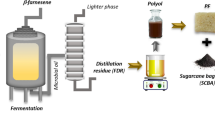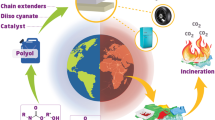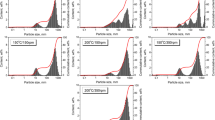Abstract
Due to the increased population in the urbanized areas, considerable attention is being paid on the development of energy-efficient buildings. In construction, the use of insulating foams has grabbed considerable attention in recent decades due to their porous structure that can reduce thermo-acoustic conductivity leading to higher energy efficiency. Nonetheless, the production of certain foams (e.g., polymer foams) is based on harmful chemical substances, such as isocyanate, as well as having difficulty being recycled. In this regard, this study adopted the use of hydrodesulfurization (HDS) spent catalyst, which is a byproduct of petroleum industry and is known to be a hazardous solid waste material, to produce a more environmentally friendly composite foam with lower thermal conductivity. In this sense, a series of material property tests, as well as thermal conductivity test, have been conducted. In addition, to further confirm the impact of HDS inclusion in the produced foams, energy cost savings and CO2 emission reduction based on their actual application in four different environments and four different fuel types for heating have been evaluated. The results are found to be highly promising and point to the great potential of utilizing HDS spent catalyst as a hazardous waste to enhance the efficiency of foams leading to CO2 emission and energy use reduction by up to 68.79 kg/m2 and 8.6 kWh/m2, respectively. Finally, this would reduce the heating cost, up to 0.69 $/m2 in an idealized building. In the end, suggestions for future studies in this area are also provided.
Graphical abstract














Similar content being viewed by others
Data availability
Not applicable.
Code availability
The authors declare that no code is used for the purpose of this article.
References
(OSHA) O. S. H. A (2022) Isocyanates - overview | Occupational Safety and Health Administration. https://www.osha.gov/isocyanates. Accessed 7 June 22
Al-Jabri K, Al-Kamyani Z, Taha R, Baawain M, Al-Shamsi K, Al-Saidy A (2013) Effect of spent catalyst as a fine aggregate on the properties of concrete. AEI 2013:662–669. https://doi.org/10.1061/9780784412909.065
Allahverdi A, Shahrbabaki MN, Ghezelasheghi M, Mahinroosta M (2019) Sulfate resistance of RFCC spent catalyst-blended Portland cement. Boletín De La Sociedad Española De Cerámica y Vidrio 58(3):103–114. https://doi.org/10.1016/j.bsecv.2018.09.001
Almeida MLB, Ayres E, Moura FCC, Oréfice RL (2018) Polyurethane foams containing residues of petroleum industry catalysts as recoverable pH-sensitive sorbents for aqueous pesticides. J Hazard Mater 346:285–295. https://doi.org/10.1016/j.jhazmat.2017.12.033
Alshamsi K, Baawain M, Aljabri K, Taha R, Al-kamyani Z (2012) Utilizing waste spent catalyst in asphalt mixtures. Procedia Soc Behav Sci 53:326–334. https://doi.org/10.1016/j.sbspro.2012.09.884
BCC Research (2022) Global polyurethane foam market. https://www.bccresearch.com/market-research/plastics/polyurethane-foam-market-report.html. Accessed 7 June 22
Bukowska M, Pacewska B, Wilińska I (2004) Influence of spent catalyst used for catalytic cracking in a fluidized bed on sulphate corrosion of cement mortars: I. Na2SO4 medium. Cem Concr Res 34(5):759–767. https://doi.org/10.1016/j.cemconres.2003.08.007
Cao G, Sheng M, Niu W, Fei Y, Li D (2009) Regeneration and reuse of iron catalyst for Fenton-like reactions. J Hazard Mater 172(2–3):1446–1449. https://doi.org/10.1016/j.jhazmat.2009.08.010
Çomaklı K, Yüksel B (2003) Optimum insulation thickness of external walls for energy saving. Appl Therm Eng 23(4):473–479
Costa C, Marques J (2018) Feasibility of eco-friendly binary and ternary blended binders made of fly-ash and oil-refinery spent catalyst in ready-mixed concrete production. Sustainability 10(9):3136. https://doi.org/10.3390/su10093136
Dufresne P (2007) Hydroprocessing catalysts regeneration and recycling. Appl Catal A 322:67–75. https://doi.org/10.1016/j.apcata.2007.01.013
Eaves D (2004) Handbook of polymer foams. In D. Eaves (Ed.), rapra Technology (1st ed.). iSmithers Rapra Publishing
Gencel O, Nodehi M, YavuzBayraktar O, Kaplan G, Benli A, Gholampour A, Ozbakkaloglu T (2022a) Basalt fiber-reinforced foam concrete containing silica fume: an experimental study. Constr Build Mater 326:126861. https://doi.org/10.1016/j.conbuildmat.2022.126861
Gencel O, YavuzBayraktar O, Kaplan G, Arslan O, Nodehi M, Benli A, Gholampour A, Ozbakkaloglu T (2022b) Lightweight foam concrete containing expanded perlite and glass sand: physico-mechanical, durability, and insulation properties. Constr Build Mater 320(January):126187. https://doi.org/10.1016/j.conbuildmat.2021.126187
Huseien GF, Mirza J, Ismail M, Hussin MW (2016) Influence of different curing temperatures and alkali activators on properties of GBFS geopolymer mortars containing fly ash and palm-oil fuel ash. Constr Build Mater 125:1229–1240. https://doi.org/10.1016/j.conbuildmat.2016.08.153
Lin JH, Lin CM, Huang CC, Lin CC, Hsieh CT, Liao YC (2011) Evaluation of the manufacture of sound absorbent sandwich plank made of PET/TPU honeycomb grid/PU foam. J Compos Mater 45(13):1355–1362. https://doi.org/10.1177/0021998310381438
Marafi M, Stanislaus A (2008) Spent catalyst waste management: a review. Resour Conserv Recycl 52(6):859–873. https://doi.org/10.1016/j.resconrec.2008.02.004
Mikoda B, Potysz A, Gruszecka-Kosowska A, Kmiecik E, Tomczyk A (2021) Spent sulfuric acid plant catalyst: valuable resource of vanadium or risky residue? Process comparison for environmental implications. Environ Sci Pollut Res 28(42):59358–59367. https://doi.org/10.1007/s11356-020-11349-z
Mills N (2007) Introduction to polymer foam microstructure. In Polymer Foams Handbook (p. 12). Elsevier https://doi.org/10.1016/B978-075068069-1/50002-7
Neves R, Vicente C, Castela A, Montemor MF (2015) Durability performance of concrete incorporating spent fluid cracking catalyst. Cement Concr Compos 55:308–314. https://doi.org/10.1016/j.cemconcomp.2014.09.018
Nodehi M, Taghvaee VM (2022) Applying circular economy to construction ındustry through use of waste materials: a review of supplementary cementitious materials, plastics, and ceramics. Circ Econ Sustain. https://doi.org/10.1007/s43615-022-00149-x
Oren OH, Gholampour A, Gencel O, Ozbakkaloglu T (2020) Physical and mechanical properties of foam concretes containing granulated blast furnace slag as fine aggregate. Constr Build Mater 238:117774. https://doi.org/10.1016/j.conbuildmat.2019.117774
Qiao L, Li N, Luo L, He J, Lin Y, Li J, Yu L, Guo C, Murto P, Xu X (2021) Design of monolithic closed-cell polymer foams via controlled gas-foaming for high-performance solar-driven interfacial evaporation. J Mater Chem A 9(15):9692–9705. https://doi.org/10.1039/D1TA01032H
Quell A, De Bergolis B, Drenckhan W, Stubenrauch C (2016) How the locus of ınitiation ınfluences the morphology and the pore connectivity of a monodisperse polymer foam. Macromolecules 49(14):5059–5067. https://doi.org/10.1021/acs.macromol.6b00494
Shaaban A, Elsabbagh AM (2022) Crashworthiness optimization of ımpact attenuators constructed of polyurethane foam. Int J Automot Technol 23(2):389–401. https://doi.org/10.1007/s12239-022-0036-8
Singh P, Gundimeda H, Stucki M (2014) Environmental footprint of cooking fuels: a life cycle assessment of ten fuel sources used in Indian households. Int J Life Cycle Assess 19(5):1036–1048. https://doi.org/10.1007/s11367-014-0699-0
Srikanth M, Asmatulu R (2013) Nanotechnology safety in the construction and ınfrastructure ındustries. In Nanotechnology Safety (pp. 99–113). Elsevier https://doi.org/10.1016/B978-0-444-59438-9.00008-4
Stovall T, Vanderlen M, Atchley., J. (2012) Closed cell foam ınsulation: a review of long term thermal performance research. Oak Ridge National Laboratory. https://doi.org/10.2172/1093061
The World Bank (2016) Solid waste management. https://www.worldbank.org/en/topic/urbandevelopment/brief/solid-waste-management. Accessed 7 June 22
Türk Standardlari Enstitüsü (2009) Thermal Insulation Requirements for Buildings. Turkish Standard - TS 825,1–60. https://sayfam.btu.edu.tr/upload/dosyalar/1458664642TS-825_Standard.pdf. Accessed 8 June 2022
United Nations (2022a) 68% of the world population projected to live in urban areas by 2050, says UN | UN DESA | United Nations Department of Economic and Social Affairs. https://www.un.org/development/desa/en/news/population/2018-revision-of-world-urbanization-prospects.html. Accessed 7 June 2022
United Nations (2022b) Cities and pollution | United Nations. https://www.un.org/en/climatechange/climate-solutions/cities-pollution. Accessed 7 June 2022
Ustaoglu A, Kurtoglu K, Gencel O, Kocyigit F (2020) Impact of a low thermal conductive lightweight concrete in building: energy and fuel performance evaluation for different climate region. J Environ Manage 268(January):110732. https://doi.org/10.1016/j.jenvman.2020.110732
Xuan D, Tang P, Poon CS (2019) MSWIBA-based cellular alkali-activated concrete incorporating waste glass powder. Cement Concr Compos 95:128–136. https://doi.org/10.1016/j.cemconcomp.2018.10.018
Yang W, Dong Q, Liu S, Xie H, Liu L, Li J (2012) Recycling and disposal methods for polyurethane foam wastes. Procedia Environ Sci 16:167–175. https://doi.org/10.1016/j.proenv.2012.10.023
Yang Y, Kadam VD, You J (2022) Thiophenes and their benzo derivatives: reactivity. In Comprehensive Heterocyclic Chemistry IV (pp. 460–518). Elsevier. https://doi.org/10.1016/B978-0-12-409547-2.14771-7
Yannas S (1985) Conservatıon practıces and potentıal ın varıous clımates. In Passive and Low Energy Ecotechniques (pp. 45–72). Elsevier. https://doi.org/10.1016/B978-0-08-031644-4.50009-6
Yarbrough DW (2010) Reflective materials and radiant barriers for insulation in buildings. Mater Energy Efficiency Thermal Comfort Build 305–318.https://doi.org/10.1533/9781845699277.2.305
Ye G, Lura P, van Breugel K, Fraaij ALA (2004) Study on the development of the microstructure in cement-based materials by means of numerical simulation and ultrasonic pulse velocity measurement. Cement Concr Compos 26(5):491–497. https://doi.org/10.1016/S0958-9465(03)00081-7
Zhao S, Fan J, Sun W (2014) Utilization of iron ore tailings as fine aggregate in ultra-high performance concrete. Constr Build Mater 50:540–548. https://doi.org/10.1016/j.conbuildmat.2013.10.019
Acknowledgements
The authors acknowledge and appreciate all the universities that supported this study.
Author information
Authors and Affiliations
Contributions
Ali Yaras, project administration, data curation, resources, and investigation; Mehrab Nodehi, writing — original draft, writing — review and editing, visualization, and validation; Abid Ustaoglu, data curation, resources, and investigation; Hasan Arslanoglu, project administration, data curation, resources, and investigation; Ahmet Sarı, project administration, data curation, resources, and investigation; Osman Gencel, supervision, project administration, methodology, resources, investigation, and conceptualization; Togay Ozbakkaloglu, supervision, project administration, methodology, and writing — review and editing.
Corresponding author
Ethics declarations
Ethics approval
Not applicable.
Consent to participate
Not applicable.
Consent for publication
The corresponding author declares consent for publication in the journal of Environmnetal Science and Pollution.
Conflict of interest
The authors declare no competing interests.
Additional information
Responsible Editor: George Z. Kyzas
Publisher's note
Springer Nature remains neutral with regard to jurisdictional claims in published maps and institutional affiliations.
Rights and permissions
About this article
Cite this article
Yaras, A., Nodehi, M., Ustaoglu, A. et al. Cleaner production of polyurethane (PU) foams through use of hydrodesulfurization (HDS) spent catalyst. Environ Sci Pollut Res 29, 88710–88724 (2022). https://doi.org/10.1007/s11356-022-21837-z
Received:
Accepted:
Published:
Issue Date:
DOI: https://doi.org/10.1007/s11356-022-21837-z




